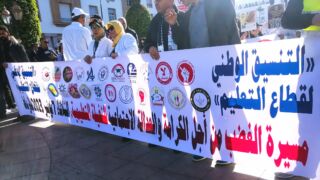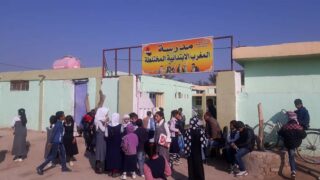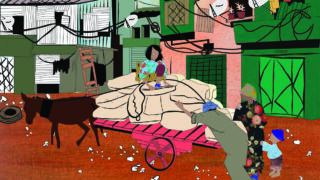
This publication has benefited from the support of the Rosa Luxemburg Foundation. This text may be reproduced in part or in full, provided the source is acknowledged.
"The climate has changed because of our many sins." This statement is often repeated by regular men or farmers in the villages during everyday talks, as many Moroccans do not believe climate change to be the result of human causes such as pollution. To them, it is a divine punishment.
Regardless, the fact is that after all this climate change, Morocco does not have four regular seasons anymore. This North African and Mediterranean country known for its moderate, alternating four-season climate is being hit, like the entire world, by the alarming consequences of climate change.
A summery fall and other disruptions
For most Moroccans, the month of October this year (2022) was far from its customary, harmless cool. In fact, it was exceptionally hot for that time of the year. The region of Souss, known for being the food basket that provides agricultural products (namely citruses and vegetables) to Morocco and most European countries, has recorded maximum temperatures between 35 and 40°C (1). Several other Moroccan cities have also witnessed unusual heat which can be described as an unprecedented summery fall. Climate experts (2) have voiced sundry arguments about the direct impact of climate change on the disruption of seasons. “Last fall was very difficult in the country”, and “the most dangerous floods in the history of Morocco were recorded during this season. Moreover, with global warming and the accelerating rise in the planet’s temperature, the water cycle has changed and become faster, more intense, and larger in volume". This indicates that “climate change is adding a new problem to the existing one, as a result of the violent extremes produced by the intensity and abundance of water.”
Climate change directly impacts on the disruption of seasons. “Fall was very difficult in the country”, and “the most dangerous floods in the history of Morocco have occurred during this season. With global warming and the accelerating rise of the planet’s temperature, the water cycle has become faster, more intense, and larger in volume.”
The small farmers are the most affected by the depletion of natural resources, which has cost them losses in their agricultural products. “Many plants have become extinct as a result of drought.” The exacerbation of this phenomenon has grave consequences, such as termite infestations, which feed on the roots of young trees and kill them.
According to global climate projections, it is expected that the mean annual temperature will rise between 1.1 and 3.5°C by 2060. Morocco lies in a hot region and it is likely that the temperature (3) in the Middle East and North Africa will rise twice as fast as the global average. The figures of the General Directorate of Meteorology in Morocco have indicated that the country loses 11 cold days every 45 years. This means that the hot periods will be longer while the cold periods will be shorter.
On the other hand, climate experts (4) have stated that climate change has grave consequences on the soil, whose nutrients have suffered immensely due to successive years of drought. “Arid lands lead to inundations, torrential floods, and soil erosion”. They are affected by the hot air currents and “cause other catastrophes, such as desertification and migration of sand dunes at the expense of agricultural soil”. Despite the presence of the Atlas Mountains which act as an impenetrable natural barrier against the encroachment of sand to these regions and as a source of fresh water that provides vegetation (especially in the Western part of the country), the regions of the Little Atlas Mountains are regularly threatened by the hot air masses coming from the desert regions.
Climate change affects natural resources
Morocco’s economy is nearly entirely based on natural resources that are associated with agriculture, industry, and marine fishery. The depletion or fragility of these resources subjects the country's economy to problems and deficits. Water is one of those vital resources that suffers from severe decline. The amount of water this year did not exceed 1.98 billion cubic meters; a decrease of 85% compared to the average annual rate. Official figures indicate that all dams recorded a filling rate of 24.8% only until September 23, 2022, as compared to 38.8% the previous year. Groundwater statistics are not very reassuring either; most groundwater layers have been overexploited. These figures show that the volume of extracted water exceeds that of the exploitable resources (about 1.1 billion cubic meters annually). The annual per capita share of water has also sharply dropped, falling from more than 3000 cubic meters in the 1960s to not more than 606 cubic meters annually. FAO expects this share to drop further in the coming few years and reach 500 cubic meters per capita, which is the threshold of absolute water scarcity (the amount of water supply which is insufficient to satisfy total demand, according to international standards). FAO views this as a "destabilizing element", warning in its 2018 North Africa and Middle East report that “the compounding nature of water and fragility gives rise to a vicious cycle, where fragility makes it more difficult for water management to be effective, in turn amplifying the negative political, social and environmental consequences of water-related challenges” in this region.
Along the same lines, official reports too have sounded the alarm about the effects of global warming in the short, intermediate and long terms. According to the reports, Morocco is threatened by "a reduction in soil fertility due to the depletion of organic matter as well as a decrease in the production of livestock, which negatively affects crop production". This leads to a "decrease in grain yields by 50 to 75% in a dry year, as compared to 10% in a normal year”.
Morocco is facing the threat of “the decline in soil fertility due to the depletion of organic matter as well as a decrease in the production of livestock, which negatively affects crop production”. This leads to a “decrease in grain yields by 50 to 75% in a dry year as compared to 10% in a normal year.
Forests, too, were not spared from these devastating impacts of global warming. Morocco, like many other countries, has recorded waves of dangerous fires in the northern and southeastern regions. The European Union's Earth Observation Program, Copernicus, stated that these fires have set a record of 480 thousand tons of carbon emissions in Morocco between June and July of this year, the highest recorded number in the past two decades.
The Moroccan coasts are threatened by disappearance or erosion at the very least. A 2021 World Bank study stated that the average sandy shoreline in Morocco retreats by 12 cm each year on the Atlantic side and by 14 cm on the Mediterranean coast, about twice the global average.
The depletion or scarcity of natural resources hits small farmers the hardest, costing them significant losses in their agricultural products. Radwan, a farmer who lives in the village of Oulad Gnaou in the north of the country, is one of 36 thousand affected beekeepers whose income relies totally or partially on this profession. He confirmed to the Green Peace that his beehives, which are his source of sustenance, have been significantly damaged.
Morocco: Who Owns the Land?
01-11-2022
Sulaliyyate Women in Morocco: This Land Is Ours
16-07-2022
Furthermore, Alhassan bin Mawla, an activist of sustainable development fighting climate change from the Figuig Province (in the northeast of the country), warned about the grave consequences of this dilemma. In the framework of the “one million trees initiative” with the farmers in the High Atlas Foundation, Bin Mawla visited some regions to follow up on the growth of trees, where he recorded the appearance of what he called "the effects of climate change". The farmers he spoke to complained about "the significant decline in the level of groundwater recently and the scarcity in rainfall".
His field research found that “many plants have become extinct as a result of drought". He also confirmed that an extremely dangerous phenomenon has taken root, which is the spread of termites that feed on the roots of small trees and kill them. "When the dryness intensifies and the land becomes in dire need of water, the depth of the wells is impacted. They now need to be dug to a depth of at least 60 meters for groundwater to be found, while they used to need not more than 20 meters”.
Renewable energy and alternative solutions
Morocco relies on multiple sources of energy, and a third of the carbon dioxide emissions comes from the energy sector, primarily from oil followed by coal. The latter generates around 40% of the country's electricity; however, Morocco is one of the 20 countries committed to limiting the building of new coal plants. Compared to developed states, Morocco’s emissions seem little, although the burning of fossil fuels to produce energy and cement is still an important source of emissions in this country, which imports most of its energy resources, and much of this imported energy is generated from fossil fuels as well.
On the other hand, Morocco has relied in parallel on renewable energy resources in the last two decades. It is the leading state in the region in terms of installed capacity of non-hydropower, producing about 800 megawatts of installed capacity to generate wind and solar energy; the greatest amount in the Middle East and North Africa. Official reports maintain that Morocco provides 2 million people with clean energy electricity. They also assert that Noor solar power plant has decreased the annual emission of greenhouse gases by one million tons.
In 2009, Morocco decided to develop an energy plan that aims to get the share of renewable energy 42% of the total installed power capacity by 2020. This program contributed to the increase in the average rate of solar and wind production throughout the second decade of this century. The capacity of photovoltaic energy was multiplied 16 times, while the average capacity of wind energy was multiplied 6 times by 2020. However, the plan did not achieve its objective since the share of renewable energy reached only 37% of the total energy in 2020. Thus, Morocco seeks to increase the rate of electricity generated by these sources to 52% by 2030 (5).
Morocco relies on multiple sources of energy. More than a third of carbon dioxide emissions comes from the energy sector. The largest amount of emissions comes from oil followed by coal, which is used to generate around 40% of the country's electricity. Morocco has relied in the last two decades on renewable energy resources. It is also the leading regional state in terms of installed capacity of non-hydropower.
The Noor II Ouarzazate Solar Power Station is known to be a profit-oriented institution; therefore, it considers that "canceling all forms of subsidies to benzene, diesel and heavy fuel oil" would contribute to "encouraging further efficient use of energy and freeing up resources for investment in green economy". In any case, the plant couldn’t care less about the negative effects these "unpopular" policies might have on the common citizens.
Morocco’s policies and commitments have closely been nearing the global goal of limiting warming to no more than 1.5°C (6). In 2021, the country pledged to the United Nations to reduce greenhouse gas emissions by 17 to 18% by 2030, while these emissions could drop by as much as 42 to 46% on the condition that international assistance is received.
In this respect, Morocco signed a “Green Partnership” with European parties within the framework of the “Paris Agreement,” which aims to consolidate the sources of renewable energies and include green hydrogen, water desalination, marine energy, carbon reduction, and investment in green technology. The cost of this partnership is 50 million Euros.
The World Bank believes that Morocco is making “bold” strides towards achieving this goal, with its plan to generate 52% of its electricity needs through renewable energy by 2030, promoting domestic manufacturing industries, through obtaining 35% of the components of the second phase for building the Noor II Ouarzazate Solar Power Station (in the southeast of Morocco) from local manufacturers. This institution is known to be profit-oriented, and so it considers that "canceling all forms of subsidies to benzene, diesel and heavy fuel oil" would contribute to "encouraging further efficient use of energy and freeing up resources for investment in the transition to a green economy". In any case, the plant couldn’t care less about the negative effects these "unpopular" policies might have on the common citizens.
As for the water resources, agreements were signed to transfer water from overflowing basins to reservoirs that suffer from deficits. The latter included Moulouya in the Middle Atlas, Tensift in the northwest, Um Er-Rbia whose source is the Middle Atlas, and Draa Tafilalet in the southeast of the country. A plan to implement the major and minor dams program was approved to raise the storage capacity to 24 billion cubic meters by 2030, in addition to the adoption of 26 mobile stations for the desalination of seawater, in order to provide potable water to 26 provinces. The plan also seeks to complete 129 small dams and lakes between 2022 and 2024. Another program was also approved to supply water for drinking and irrigation purposes in the period between 2020 and 2027, with a cost of 115 billion dirhams (around 11 billion US dollars).
The question remains…
It seems that Morocco is taking, in comparison to other states in its region, some fairly ambitious steps towards energy transition. However, it is hard to answer the following question with a simple yes or no: Will renewable energy save the country from the dangers of climate change? That is why the most essential question that is being and will continue to be asked in the coming years concerns the extent of the concerned parties’ commitment to these agendas in their sustainable dimension that affects the population and the environment and is removed from the policies that seek huge profits.
The content of this publication is the sole responsibility of Assafir Al-Arabi and Rosa Luxemburg Foundation cannot accept any liability for it.
Translated from Arabic by Ghassan Rimlawi
Published in Assafir Al-Arabi on 10/11/2022
1- The highest temperature was recorded in Agadir (in the Southwest of Morocco) in the region of Souss which is known for its import-oriented agricultural products.
2- According to the statements of climate expert Muhammad Saeed Karouq on a local platform.
3- According to the projections of the Max Planck Institute for Biophysical Chemistry.
4- According to the statements that climate expert Ali Shroud made to a local news platform.
5- 20% from solar energy, 20% from wind energy, and 12 % from hydropower,
6- According to the analysis of The Climate Action Tracker (CAT).





